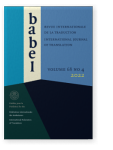Vol. 68:4 (2022) ► pp.477–497
Jordanian Arabic euphemizers in English translation
This study investigates a special category of euphemism, i.e., euphemizers (Farghal 2012). It makes a key distinction between euphemism which is normally engineered to mitigate the impact of a certain specific expression in a structure through substituting it by a milder one, and euphemizer which is seen as a scene-setter for and an impact-softener of the entire topic or discourse in any given communicative situation. As far as the Politeness Principle (Leech 1983) and the Cooperative Principle (Grice 1975) are concerned, the study shows that euphemizers in Jordanian Arabic have been found to be exploited to generate particularized rather than generalized conversational implicatures or floutings as to achieve certain communicative politeness-related purposes, such as softening the overarching negative force of the entire discourse, soothing the fury of interactants, showing respect, high-esteem, friendliness, warmth, and hospitability. These purposes emerge as the raison d’être behind such a pervasive “socio-discoursal deodorization.” Analysis also shows that the pragmatic translation proved to be an appropriate, but to a large extent, a dominant strategy that has aptly been opted for in dealing with many cases that match with English, whereas the deletion or zero-translation strategy, to a lesser extent, has been applied to unmatchful ones.
Article outline
- 1.Introduction
- 2.The issue at stake: Euphemizers
- 3.Theoretical background
- 4.Methodology
- 5.Discussion
- 6.Conclusion
-
References
